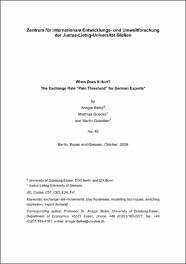| dc.description.abstract | The paper deals with the impact of the exchange rate on the relationship among German exports and its main determinants. Our main aim has been to identify an exchange rate pain threshold for German exporters. We rely on a nonlinear pathdependent model in which suddenly strong spurts of exports occur when changes of the exchange rate go beyond a so called "play area" (which is similar to the phenotype of play in mechanics). We capture this on-linear dynamics in a simplified linearized way and implement an algorithm describing linear play hysteresis into a suitable regression framework. Our non-linear model including play displays a much better performance than the standard linear model. Thus, the implications of some When Does It Hurt? The Exchange Rate "Pain Threshold" for German Exports hysteretic macro models concerning the dynamics of aggregate labor demand are corroborated empirically for trade variables as well.
Moreover, we are able to show that the frequently mentioned notion of an exactly identified unique "pain threshold" of the $/€ exchange rate simply does not exist. Instead, we come up with an estimate of a path-dependent play area width of 24 US dollar cent per euro for total German exports to the US. Taking into account that the borders of the play area and, thus, also the "pain threshold" (as the upper border) "today" depend on the historical path of the RER until "today", the location of the play area and the "pain threshold" is dependent on the observation point in time.
For instance, at the end of our estimation period, our estimation results imply a "pain threshold" of 1.55 $/€ which continued to hold in October 2009. Compared to the more recent laments of business German business representatives and also to the more recent implicit assessment by the ECB this threshold is slightly but not substantially higher. On October 22nd, 2009, the dollar hit the 1.50 level, implying that we are currently not too far away from this threshold especially if we take into account that macroeconomic uncertainty has shrunk slightly but steadily since the turn-of-the-year 2008/09. However, laments appeared to be quite contained these days until very recently. The interesting question then is why this time "it was so different". We feel legitimized to preliminarily argue that maybe the awareness of appreciation of the euro has been overlaid and dominated by the public reception of the economic and financial crisis.
But as in recent episodes of local maxima of the $/€ exchange rate, also the ECB is also now apparently becoming increasingly aware that a stronger euro must absolutely be avoided. Further euro strengthening in the remainder of the year will have a significant impact on 2010 economic growth, for instance, in export dependent Germany, and make the ECB s own pessimistic forecasts for this year even more probable. Hence, this may become a new era of the ECB s rhetoric on exchange rates because (i) it will be the euro area which will have to bear the burden of the global adjustment and (ii) voting majorities in the ECB Council have changed in the meantime to the benefit of former weak currency countries which are inclined to enact central bank interventions in the FX markets in order to weaken their home currencies.
What does all this lead us? If, as a result of global imbalances, the external value of the euro increases even further, the demand for German exports will fall dramatically and (units of) German firms reduce or even stop trading internationally, then reentrance into international trade will be severely hampered, even if the euro will devaluate again in the future. So, once there will be a zero entry in any export good category, the concern is that it is going to be hard for exporters in this goods category to re-establish their export nodes and get back in. A German firm may even be likely to decide not to re-establish global trading networks again, or, at a minimum, it might take some time before it well be capable of doing so. Hence, the "ever rising euro" may have consequences that go well beyond the prediction of any standard economic model incorporating a unique exports equilibrium, when the presence of global trading networks and sunk costs of for German exporters is acknowledged. | en |



